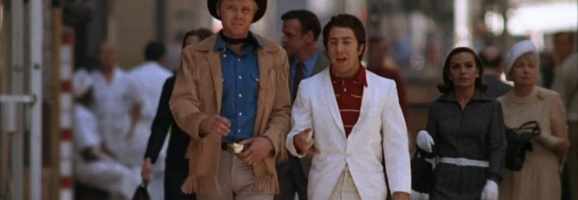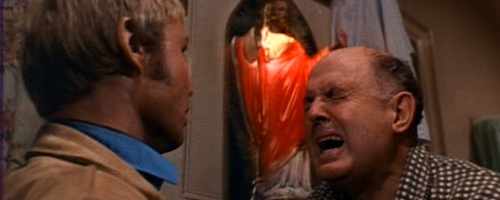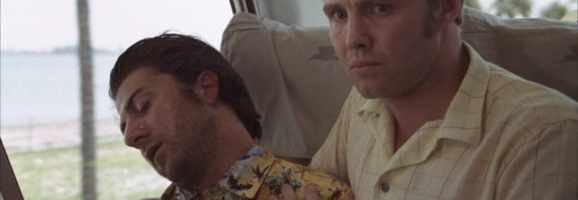Midnight Cowboy: The Fractured American Identity
One of the most prevalent and obvious motifs in John Schlesinger’s 1969 film Midnight Cowboy is protagonist Joe Buck’s (Jon Voight) identity as a “real cowboy.” Throughout the film, each character Joe meets on his quest questions whether or not he is a real cowboy because of the cowboy outfit he wears. He usually answers “no,” he’s not a real cowboy.

The plot of Midnight Cowboy is as follows: Joe Buck, a handsome Texan dishwasher, packs up and moves to the Big Apple, hoping to make easy money as a prostitute for what he perceives as a rich, middle-aged class of bored women. New York City is a lot tougher than he thought, and his hustling is ultimately unsuccessful. He meets Enrico Salvatore Rizzo, or Ratso (Dustin Hoffman), a crippled street con man who eventually seems to have a heart of gold, and the two bond over surviving with little money. The two struggle as Ratso’s health diminishes and Joe’s series of clients offers little in the way of cash. They end up at a Warhol-type psychedelic party (possibly the weakest moment of the film), where Joe actually leaves with a female socialite who promises to pay for his services.
Everything seems positive, as the woman promises Joe’s services to her friends, meaning Joe’s got work, but when he returns to Ratso’s rundown apartment, his friend’s health has worsened. What follows is a heartfelt and possibly, ultimately, soap operatic attempt to get Ratso to Miami, a place he’s always dreamed of going, before he dies.
Joe Buck’s story is an old one, with its roots in American tenacity, the American Dream. Theodore Dreiser tells approximately the same tale in Sister Carrie (1900), where a young country girl moves to the big city (Chicago) and ends up being a “mistress” to wealthy men before realizing her dream of becoming an actress. This follows in the vein of the Horatio Alger “rags to riches” narrative, the same narrative that Henry Miller wished to “wipe out of the North American consciousness.” In the post-World War world, it was widespread knowledge that these notions were bunk, with much of the avant-garde out for the American Dream’s blood.
Midnight Cowboy is one of those anti-American Dream narratives that seeks to show America’s underbelly, greasy, dark, and starving. But unlike expatriate Miller, Joe Buck is entirely American, a bright-eyed, handsome youth with dreams of making it big in the city, all while refusing to remove his American costume, his cowboy outfit.
American media has always had a romantic fascination with cowboy life, and Joe’s fascination is no different. Despite western genre films rarely depicting what actual cowboy life is like, these films have become a symbol of an ideal American ambition, with actors such as John Wayne embodying this ideal.
Thus it is appropriate when Ratso tells Joe to lose the cowboy clothes or risk being perceived as a homosexual prostitute by clients on the street. Joe refuses to believe that a cowboy getup is a sign of homosexuality in New York City, his ideal image of the American man, and challenges Ratso. “John Wayne, you’re gonna tell me he’s a fag?” he cries, almost in tears.
Although the depiction of homosexuality in the film may seem dated (or even offensive), it must be read at face value: homosexuality here, to Joe, is seen as tarnishing the American cowboy image, which, in reality, was merely a fictitious, romantic (and naive) version of the truth. In westerns, cowboys are shown to be tough, hardworking, and above all, a symbol of justice and the American way. Most cowboys fight Native Americans, which is purely a Hollywood trope more than a historical fact. The hero cowboy is a Hollywood lie, and Joe Buck never realized this.

When riding the bus to New York, Joe listens to his radio, and when the radio picks up a New York City station, he knows he is there. The station is polling women about the types of men they like, and many of them answer in ways that follow the “tall, dark, and handsome” ideal, which, like the cowboy, is just not real. However, this excites Joe, who instantly believes himself to be what women are looking for.
It is the radio that leads Joe Buck, gives him comfort when the electric Jesus scare him away, when he doesn’t have a friend in the world. Joe’s obsession with his radio embodies America’s own fascination with media, be it a moral or immoral one. That being said, the electric Jesus that Joe’s first pimp makes him pray at is just as phony, if not more, than the radio’s divine guidance. Joe learns that everything is phony, and eventually must pawn his prized possession, the only thing he owns, for some small amount of cash.
The film revolves around Joe’s need of money, and another of its motifs is the Mutual of New York building, which flashes the letters M, O, N, and Y in the night sky. Commercialism and bright lights line the streets of New York, and each street seems to be hiding gold, but New York City is not the city Joe thought it would be. His romantic notions of being a hustler for wealthy women are quickly dashed as he staggers through parks and alleyways.
In one poignant scene, Joe sleeps with a woman in a penthouse in the hopes that she will pay him (she doesn’t), and while they’re in bed, the tv flips through channels at a schizophrenic pace, showing an absurd number of advertisements and other inane programming. This scene mixes together commercials with sex, money and lust, mixes them into an unreadable, unreal situation that is nauseating, confusing, and, for Joe, unrewarding. While the scene may seem a bit on the nose for contemporary viewers, it holds the film’s thesis, that Joe’s naive ambitions and his ideal America are just that, naive, and that he will not earn money, no matter how many bus trips he takes.

Midnight Cowboy is a film that begins on a bus, and ends on a bus. The American cannot sit still, must constantly travel, devouring experience, in order to “make it big.” The film embodies the notion of leaving the country for the big city, and is an education against it, a wary tale for starry-eyed kids. In another Dustin Hoffman film, The Graduate (1967), the film ends as Hoffman’s character escapes on a bus with the girl he is in love with. Throughout that film, Hoffman’s character wanders aimlessly through his old town after graduating college. That film too dispels an American myth, and Midnight Cowboy can be read as a sort of sequel, about what happens when Hoffman’s character gets off that bus and back into the gritty world.
Midnight Cowboy‘s title evokes the essential American narrative, the western, but it is no such thing. The film’s script and its actors attempt to portray the truth, in as honest a way as they can, of life on the streets of Times Square.
Its message and thesis may not be as striking today as it when when the film was released, and it sometimes feels particularly dated. Joe Buck’s flashbacks, which seem to reveal the traumatic experiences of his youth, usually harm the film rather than enhance it. The Warhol-type party was dated even in 1969.
If nothing else, the film succeeds in its portrayal of the friendship of Joe and Ratso, two outcasts trying to make a buck. While initially rocky, their friendship blooms into an almost married couple-esque relationship, and in the end, each truly cares about the other. Against the sex and ads and the MONY sign and the Warhol party, Joe and Ratso’s relationship is the only real thing in the whole film.
What do you think? Leave a comment.











I just watched this film recently and was pleasantly surprised at how entertaining it is – I thought it would be really dated but its a story that could easily be remade again today, although I hope they leave this one alone.
Yeah, Voight and Hoffman are perfect.
The opening scene when he’s walking out of the diner through the town, with Nilsson’s ‘Everybody’s Talkin’ is, IMHO, the best movie opening/credit/musical sequence in movie history. I love the song, it just fit in with the whole mood/tone of the film so well, carefree, wistful…just perfect.
When I was in a film class in college years ago, the instructor showed us the opening of Midnight Cowboy one day as an example when he was lecturing about the power of a a good opening. I remember he said, “Now how could you not want to keep watching to learn more about this Joe Buck character?” I had already seen the movie, but I totally agreed and still do.
Really great, sad song. One of Nilsson’s best.
I came across this film on Netflix – it is really moving and I really enjoyed it.
Probably the most complete film ever in terms of just about every facet of the picture is top notch.
I really like the film, but I’m not sure it’s one of the most complete and top notch…I think the most perfect film I’ve ever seen is Boogie Nights or Bergman’s the Seventh Seal ; )
very interesting to see this film viewed through western perameters. although i never thought of it in this way it is extremely valid and forces me to reevaluate my conception of the film, which usually stems from it being a representation of the time period in American filmic history.
Thoughtful article. Particularly nice is the section about how this classic gritty 70’s film is essentially a take-down of the sanitized Hollywood western, especially because it’s so different on the surface. The realization that both ‘Midnight Cowboy’ and ‘the Graduate’ end on a bus is also powerful if one imagines the latter’s buffered Ben as morphing into Ratso when the 60’s wind down and some kind of reality hits. Dustin Hoffman is a true chameleon.
The Graduate is still one of my favorite films, but I think its worldview is sort of naive in a teenagish way, which is still honest and valid, but in the context of Midnight Cowboy, transforms into something else ; )
It definitely does transform it in comparison. There’s a weird kind of communication between the two films then which is like a new story…
I took a composition course my freshman year that revolved around the theme of the cowboy and the modern American hero, and while originally a bit exasperated, to this day it is one of the best courses I have ever taken. We didn’t watch Midnight Cowboy but I wish we did. What we did do though, was take the Social Network, and compare Mark Zuckerberg to a modern day cowboy of sorts…
Wow, that class sounds great. I like the idea of a Zuckerberg modern cowboy, and the implications of it. Cool!
A splendid film, so eye-opening and emotionally powerful! I like your analysis of the fragmented American identity; as you said it very clearly, this film is a perfect illustration of the lost American Dream. All those people who believed so much in it, kept looking and failed to catch life’s true essentials. This is one of my favourite films, and Dustin Hoffman delivers once again a truly amazing performance. The music is hauntingly beautiful, I kept listening to it all summer, it kind of makes you feel both happy and devastated at the same time. Just like the film. Thank you for this article 🙂
First off, I totally agree that the psychedelic scenes were the weakest part of the film. Besides the flashbacks, this film was very entertaining. But your point that the American Cowboy is an ideal more than a reality is intriguing. Looking at advertising, the Marlbolo Man became an iconic cowboy figure during the late 1950s. The cowboy figure stood as the epitome of masculinity, and it seems Joe feels this way too which is why, as you pointed out, he’s shocked at the notion that a cowboy could be equated with homosexuality.
And with gay men often being viewed as feminine by society, it’s ironic that the Marlboro Man was initially created to sell filtered cigarettes because these cigarettes were considered feminine. In one instance, a cowboy is used to make money and in another a cowboy could prevent a profit.
this is the absolute most depressing movie
John Barry’s theme in the movie just rips out the heart !!!!! This movie really tells us that we love things even in the most difficult of times but that love often does not last long!!! So value and hold on the true love on has for it is rare!!! It was rare in 1969 and in the recent era of cut throat competition there is a huge paucity of the same. !!! Cheers to the times when movies were all about good genuine acting and a pitch perfect John Barry Soundtrack !!!
I think one thing that is missing in the analysis is the many hints at homosexuality during the movie and Joe’s attempt to show that he is not. At the end, the person that sets him on a straight line again is a man. Not a homosexual relationship but his closest friend was make. Pretty strong statement from a rated X movie.
I agree. I think Joe has suppressed homosexual feelings. I also think that the relationship between Joe and Rizzo was a deeper level than just friendship. I’m not implying it was a sexual relationship by any means, but I think there was almost a ‘couple’ dynamic. Hoffman and Voight even came to that realization when acting the movie.
I have never loved this movie. I try to explain why to people why and they freak out. Roger Ebert does a fantastic job in his 1969 review.
https://www.rogerebert.com/reviews/midnight-cowboy-1969
There appear to be flashbacks to Joe Bucks childhood, living with his grandmother . The film touches on the idea of childhood sexual abuse. Joe is seen in bed between his grandmother and her man friend . We see her constantly kissing him throughout the movies. Joes reactions to this” affection” are negative.
Perhaps these early experiences “prepare” him for the world of prostitution . What do you think? Comments encouraged,
I wonder how much years you had when you wrote this one. Some of the thesis are not supported and the other ones are ok. But in my opinion you are revolving the movie around two topics, which makes you miss the point.
Btw when i was reading this, it felt like i was reading kinda my essay work, which i would describe as a naive, hot – headed, but with short sentences that are supporting the whole essay ; ”Midnight Cowboy is a film that begins on a bus, and ends on a bus. ” . Thanks for sharing
In a sense, the image of the cowboy (a symbol of a pastoral, free world) was symbolically killed here.